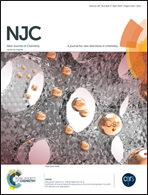Novel nitrogen precursors for electrochemically driven doping of titania nanotubes exhibiting enhanced photoactivity
Abstract
Nitrogen doped titania nanotubes were successfully sensitized by the electrochemical method, i.e. as-anodized titania was immersed in different amine (diethylenetriamine – DETA, triethylamine – TEA, and ethylenediamine – EDA) and urea (U) solutions and a constant potential was applied. The highly ordered morphology of fabricated N-TiO2 was investigated by scanning electron microscopy. Spectroscopic techniques, i.e. UV-Vis spectroscopy, Raman spectroscopy, X-ray photoelectron spectroscopy and photoluminescence spectroscopy, were utilized to characterize absorbance capability and the crystalline phase, to confirm the presence of nitrogen atoms and to study charge recombination, respectively. The highest photocurrent under both UV-Vis and visible illumination (λ > 420 nm) was registered for the N-TiO2 sample obtained from diethylenetriamine solution, used as a nitrogen precursor. The photocurrent density exhibited during UV-Vis irradiation by the most active nitrogen doped titania was 2.83 times higher compared to pure TiO2 nanotubes. The photocatalytic activity studies demonstrated a significant improvement when N-TiO2–DETA (52%) and N-TiO2–U samples (49%) where used instead of undoped TiO2 (27%). The presented results show that electrochemical doping with 0.5 M amine or urea solutions is a simple, cheap and effective strategy to introduce nitrogen atoms into the titania structure without affecting its morphology.


 Please wait while we load your content...
Please wait while we load your content...